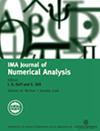近接触夹杂物完美电导率问题的收敛有限元方法
IF 2.3
2区 数学
Q1 MATHEMATICS, APPLIED
引用次数: 0
摘要
在完全导电性问题(即包含完全导电性的内含物的导电性问题)中,电场梯度在两个内含物之间的狭窄区域通常非常大,并随着内含物之间的距离趋于零而急剧增大。对于一般几何形状的近接触包体的完美电导率问题的计算,严格的误差分析在三维上仍然是开放的。我们通过建立新的二阶偏导数的渐近估计来解决这个问题,该估计明确依赖于包裹体之间的距离$\varepsilon $,并使用渐近估计来设计一类梯度网格和有限元空间,以解决可能接近接触的包裹体的完美电导率问题。特别地,我们提出了一个特殊的有限元基函数,它通过使插值误差在接近接触点的邻域中限定在$W^{1,\infty }$来解决解的渐近奇异性,即使解本身在$W^{1,\infty }$中爆炸。这在数值近似的误差分析中是至关重要的。我们证明了所提出的方法在二维和三维的$H^1$范数中,对于可能接近接触的一般凸光滑内含物,在包含物之间的距离$\varepsilon $一致地产生最优阶收敛。数值实验支持了理论分析,并说明了所提出的方法在二维和三维范围内对不同形状夹杂物的收敛性。本文章由计算机程序翻译,如有差异,请以英文原文为准。
Convergent finite element methods for the perfect conductivity problem with close-to-touching inclusions
In the perfect conductivity problem (i.e., the conductivity problem with perfectly conducting inclusions), the gradient of the electric field is often very large in a narrow region between two inclusions and blows up as the distance between the inclusions tends to zero. The rigorous error analysis for the computation of such perfect conductivity problems with close-to-touching inclusions of general geometry still remains open in three dimensions. We address this problem by establishing new asymptotic estimates for the second-order partial derivatives of the solution with explicit dependence on the distance $\varepsilon $ between the inclusions, and use the asymptotic estimates to design a class of graded meshes and finite element spaces to solve the perfect conductivity problem with possibly close-to-touching inclusions. In particular, we propose a special finite element basis function that resolves the asymptotic singularity of the solution by making the interpolation error bounded in $W^{1,\infty }$ in a neighborhood of the close-to-touching point, even though the solution itself is blowing up in $W^{1,\infty }$. This is crucial in the error analysis for the numerical approximations. We prove that the proposed method yields optimal-order convergence in the $H^1$ norm, uniformly with respect to the distance $\varepsilon $ between the inclusions, in both two and three dimensions for general convex smooth inclusions, which are possibly close-to-touching. Numerical experiments are presented to support the theoretical analysis and to illustrate the convergence of the proposed method for different shapes of inclusions in both two- and three-dimensional domains.
求助全文
通过发布文献求助,成功后即可免费获取论文全文。
去求助
来源期刊
CiteScore
5.30
自引率
4.80%
发文量
79
审稿时长
6-12 weeks
期刊介绍:
The IMA Journal of Numerical Analysis (IMAJNA) publishes original contributions to all fields of numerical analysis; articles will be accepted which treat the theory, development or use of practical algorithms and interactions between these aspects. Occasional survey articles are also published.

 求助内容:
求助内容: 应助结果提醒方式:
应助结果提醒方式:


